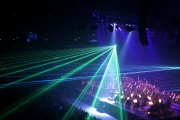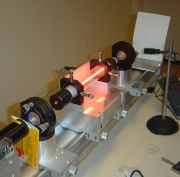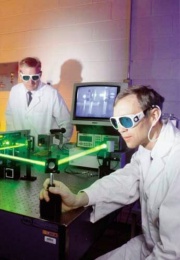Difference between revisions of "Laser"
(username removed) |
|||
| Line 4: | Line 4: | ||
Originally an acronym for ''light amplification by stimulated emission of radiation''. Common usage, however, has applied the term laser to any of several devices that convert a wide range of electromagnetic frequencies into one coherent frequency. This is done by exciting the atoms to reach a higher energy level where their wavelengths are in a single phase. The resultant laser beam has extremely intense energy. Lasers, first patented in 1960 by Bell Labs, have now been made using ultraviolet, visible, infrared, and microwave wavelength regions. Lasers are used in communication (optical fibers, satellites), medicine (surgery), spectroscopy (FT-IR, Raman, mass spectrometry), photography (holography) and for geographical mapping in difficult locations (planets, moon, ocean floor). Lasers have been used to remove encrustations, overpaint, soot, stains, fungi, and graffiti from several types of surfaces (Asmus 1978 and 2000). | Originally an acronym for ''light amplification by stimulated emission of radiation''. Common usage, however, has applied the term laser to any of several devices that convert a wide range of electromagnetic frequencies into one coherent frequency. This is done by exciting the atoms to reach a higher energy level where their wavelengths are in a single phase. The resultant laser beam has extremely intense energy. Lasers, first patented in 1960 by Bell Labs, have now been made using ultraviolet, visible, infrared, and microwave wavelength regions. Lasers are used in communication (optical fibers, satellites), medicine (surgery), spectroscopy (FT-IR, Raman, mass spectrometry), photography (holography) and for geographical mapping in difficult locations (planets, moon, ocean floor). Lasers have been used to remove encrustations, overpaint, soot, stains, fungi, and graffiti from several types of surfaces (Asmus 1978 and 2000). | ||
| − | See also [ | + | See also [[laser pointer]]. |
[[File:Laserlightf5.jpg|thumb|Laser tube]] | [[File:Laserlightf5.jpg|thumb|Laser tube]] | ||
| + | |||
== Synonyms and Related Terms == | == Synonyms and Related Terms == | ||
Revision as of 10:39, 21 January 2014
Description
Originally an acronym for light amplification by stimulated emission of radiation. Common usage, however, has applied the term laser to any of several devices that convert a wide range of electromagnetic frequencies into one coherent frequency. This is done by exciting the atoms to reach a higher energy level where their wavelengths are in a single phase. The resultant laser beam has extremely intense energy. Lasers, first patented in 1960 by Bell Labs, have now been made using ultraviolet, visible, infrared, and microwave wavelength regions. Lasers are used in communication (optical fibers, satellites), medicine (surgery), spectroscopy (FT-IR, Raman, mass spectrometry), photography (holography) and for geographical mapping in difficult locations (planets, moon, ocean floor). Lasers have been used to remove encrustations, overpaint, soot, stains, fungi, and graffiti from several types of surfaces (Asmus 1978 and 2000).
See also Laser pointer.
Synonyms and Related Terms
laser (Dan., Deut., Fr., It., Ned., Nor., Pol., Port., Sven); láser (Esp.);
Other Properties
Classifications:
Class 1: Safe for use in most anticipated exposure conditions
Class 2: Visible light laser whose prolonged viewing is dangerous to the human eye
Class 3B: Direct viewing of beam is hazardous, diffusely reflected beam should not be hazardous
Class 4: High power lasers that are hazardous to eyes and skin at all times
Hazards and Safety
Can irreparably damage the eyes.
Additional Information
° J.Asmus, "Light Cleaning: Laser Technology for Surface Preparation in the Arts", Technology & Conservation, 3/78, p. 14-18. ° J.Asmus, Workshop on Laser Cleaning, AIC meeting, Philadelphia, June 2000.
Authority
- Encyclopedia Britannica, http://www.britannica.com Comment: "laser" Encyclopædia Britannica Premium Service. [Accessed 25 Jan. 2006].
- Website address 1 Comment: Laser Classifications at: http://ptcl.chem.ox.ac.uk/MSDS/laser_classification.html
- Wikipedia, the free encyclopedia, at http://www.wikipedia.com Comment: http://en.wikipedia.org/wiki/Laser (Accessed Sept. 28, 2005)
- Richard S. Lewis, Hawley's Condensed Chemical Dictionary, Van Nostrand Reinhold, New York, 10th ed., 1993
- Hoechst Celanese Corporation, Dictionary of Fiber & Textile Technology (older version called Man-made Fiber and Textile Dictionary, 1965), Hoechst Celanese Corporation, Charlotte NC, 1990
- Van Nostrand's Scientific Encyclopedia, Douglas M. Considine (ed.), Van Nostrand Reinhold, New York, 1976
- Random House, Webster's Encyclopedic Unabridged Dictionary of the English Language, Grammercy Book, New York, 1997
- The American Heritage Dictionary or Encarta, via Microsoft Bookshelf 98, Microsoft Corp., 1998


